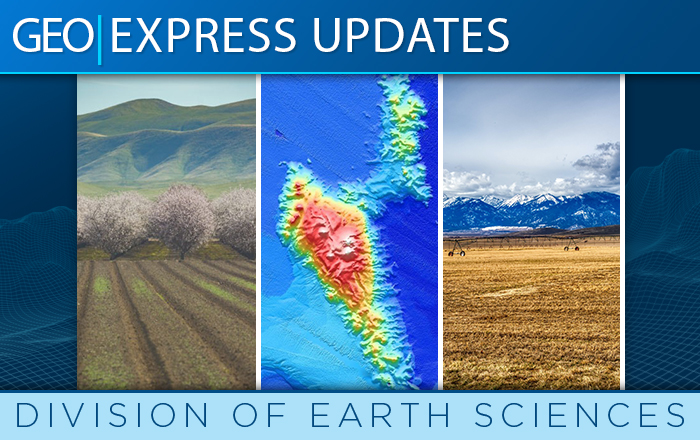NSF Earth Sciences Express Update - Spring 2020
May 20, 2020
|
A Vision for NSF Earth Sciences 2020-2030: Earth in Time |
|
COVID-19 Information for the Geosciences Research Community |
|
From the Division Director - On the Passing of Former Program Director Dr. Doug James |
|
Congratulations to Dr. Jennifer Wade, who began her Acting Section Head appointment on April 13. The Disciplinary Programs Section of EAR will benefit from Dr. Wade's vast experience and great initiative. The Division would like to thank Dr. Dena Smith-Nufio for serving as Acting Section Head with strong leadership and great success. |
|
EAR welcomes Dr. Jessica Robin as the new Head of the Integrated Activities Section in the Division of Earth Sciences. Dr. Robin has served NSF and the scientific community for many years. EAR will benefit from her experience working with high profile programs, building coalitions and consensuses, and making strategic decisions. She brings a wealth of experience and expertise to the Division to complement our current capabilities. |
|
EAR hosted virtual office hours in April focused on NSF’s COVID-19 guidance to the research community. In case you missed it, the webinar presentation slides can be found here. In addition, the NSF Coronavirus website includes NSF guidance for grantees, panelists, and reviewers, as well as Frequently Asked Questions, and links to additional NSF guidance and Federal resources. NSF’s Office of Polar Programs website also includes information on How USAP is responding to COVID-19 challenges and planning for the upcoming season. |
|
The EAR Communications Team has developed four activity worksheets aimed at elementary school students. Topics include paleobiology, plate tectonics, photomicrographs, and the hydrologic cycle. The worksheets are available for download here. |
|
EAR will host virtual office hours on Thursday, May 21 from 3:00-4:30 pm EDT, focused on “Navigating the NSF System”. This is a good opportunity for first time proposers and early career scientists to gain insight to the ins and outs of the grant proposal process. Register for the webinar here. |
|
New ICURC Solicitation - NSF 20-570 |
|
Career Opportunities |
|
EAR-funded Research in the News |
|
Sediment loading is key to predicting post-wildfire debris flows |
|
How did marine animals become so diverse? |
|
Scientists determine early Earth was a ‘water world’ by studying exposed ocean crust |
|
Sinking seamounts make and muffle earthquakes |
|
Recovering phosphorus from corn ethanol production helps reduce groundwater pollution |
|
Earth's mantle, not its core, may have generated planet's early magnetic field |
|
The life and death of one of America's most mysterious trees |
|
California's air quality regulations help farmers prosper |
|
Co-occurring contaminants may increase North Carolina groundwater risks |
|
Stream pollution from mountaintop mining doesn’t stay put in the water |
|
Changes in snowmelt threaten farmers in western United States |
|
Tectonic plates started shifting earlier than previously thought |
|
Researchers discover 66-million-year-old badger-like animal |
|
Fiber Optic Seismic Array in Pasadena Tracked the Rose Parade |
|
Community News |
|
40th anniversary of Mt. St. Helens eruption |
|
Ethan Baxter, EAR PI from Boston College, is developing a video series titled "Every Rock Has A Story" aimed at students, grades K-4. The series is designed to help students, parents, and teachers explore, draw, learn, and get excited about rocks and the Earth. |
|
There is still time to register for the 2020 Goldschmidt Virtual Conference which will take place June 21-26. For more information, please visit the conference website. |
|
Giant Screen Films, who produced the NSF-funded Dinosaurs of Antarctica, has made their other well-known dinosaur IMAX film, “Dinosaurs Alive!” (NSF 0337269) available free for streaming until June 15th. NSF News Release 09-236 details some of the funded research that was featured in the film. |
The U.S. National Science Foundation propels the nation forward by advancing fundamental research in all fields of science and engineering. NSF supports research and people by providing facilities, instruments and funding to support their ingenuity and sustain the U.S. as a global leader in research and innovation. With a fiscal year 2023 budget of $9.5 billion, NSF funds reach all 50 states through grants to nearly 2,000 colleges, universities and institutions. Each year, NSF receives more than 40,000 competitive proposals and makes about 11,000 new awards. Those awards include support for cooperative research with industry, Arctic and Antarctic research and operations, and U.S. participation in international scientific efforts.
Connect with us online
NSF website: nsf.gov
NSF News: nsf.gov/news
For News Media: nsf.gov/news/newsroom
Statistics: nsf.gov/statistics/
Awards database: nsf.gov/awardsearch/
Follow us on social
Twitter: twitter.com/NSF
Facebook: facebook.com/US.NSF
Instagram: instagram.com/nsfgov

